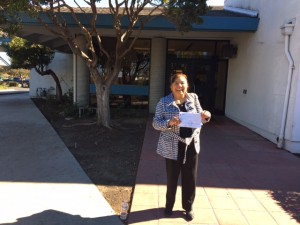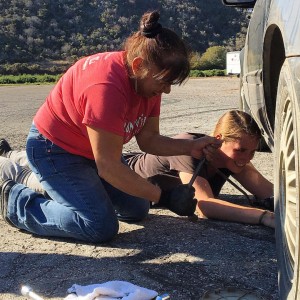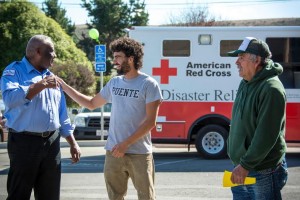Paula Arriola has never been comfortable behind the wheel.
The mother of three has lived in Pescadero for 9 years, but has never driven farther than Morgan Hill. Like thousands of other undocumented Californians, she found herself obliged to drive without a license or any formal driver’s training. You can’t get around the South Coast without a car. But she restricted herself to getting to and from work and taking her daughter to school. “It does make me nervous,” she acknowledges.
It doesn’t help that Arriola, a single mother, has been driving around an old, beat-up car she kept from her former marriage. It doesn’t have an odometer, which is nerve-wracking because she’s always worried that she is speeding.
“I never know how fast I’m driving. I just follow the car in front of me. When there’s a car behind me, I just pull off to the side of the road and let them pass,” she says.
Arriola, whose name has been changed for this story, decided that 2015 would be a year of opportunity. She was emboldened by AB 60, the California law that, as of January 2015, gave all qualified residents the right to apply for a driver’s license regardless of legal status. She wanted a legal license and she wanted her own new, safer car. Her daughter Daisy, a college-bound 18-year-old, was working hard to earn her own driver’s permit and license. (Daisy passed both tests and received her license in September).
But the biggest incentive was hearing that Puente was teaching a class on the rules of the road, specifically to prepare students to pass the DMV “traffic laws and signs” test. And that the class was women-only, and taught by a woman, in Spanish and tuition-free.
Puente launched its AB 60 program in August 2014, with a community workshop to answer questions about the documentation and overall process required to get a legal driver’s license. Locals learned they would need proof of residency and photo identification. The latter could be obtained from the Mexican Consulate in San Francisco, something Puente helped facilitate for dozens of residents.
More than 549,000 undocumented Californians have become licensed drivers since the law went into effect, according to DMV estimates.
In late 2014, Ben Ranz, Puente’s Community Outreach Coordinator, began teaching classes on the rules of the road based on the DMV driver’s manual to help people pass the written test. He passed that role over to Charlea Binford, Puente’s Adult Education Coordinator who also teaches ESL and other Adult Education classes at Puente.
The class is an indispensable tool to help students manage their anxiety about passing the dreaded DMV test by helping them take practice tests, says Binford. There is a tremendous amount of material to memorize, so each class spends two months preparing for it. At the DMV, students can take the written test in Spanish. They can opt to fill out the answers on paper, on a computer screen, or via audio prompts which they answer orally.
Slowly, the numbers are climbing.
“We know of 48 people who have passed their written test. 18 of those 48 are women. 33 of those 48 have gone on to pass the road test,” says Ranz. Overall, Puente has helped 144 people in one way or another through the driver’s license process – whether that’s attendance at an informational session, making an appointment at the DMV, or help getting an ID. Puente even offered one class for farm workers who were never taught to read or write.
The idea for a women’s class came to Rita Mancera and Kerry Lobel, Puente’s leaders, when they noticed the low enrollment of female students in Puente’s co-ed driving classes. A class for women, taught by a woman, held the promise of a safe space where women could speak up without fear and learn at their own pace.
It was also a practical issue. “We knew they were already driving. We saw them bringing their children to school or going to get their groceries. The challenge was to help them a pass the laws and signs test,” says Mancera, Deputy Executive Director of Puente.
In class, students learn driving tips, as well as how to read hard-to-understand road signs, which are full of English words they may not know, and little mnemonic tools to help them memorize things like which way to turn the driving wheel when parking on a hill.
Even though she’s been driving for years, Arriola learned valuable information in class – like the importance of strapping her 7-year-old daughter into her child’s seat every single time they go for a drive, no matter how close their destination may be.
Many lessons are learned in the course of group conversations that build everyone’s confidence, because students teach each other the rules that they already know.
“I think men’s energy can change the dynamic of a group. This was the first time I’ve taught an all-women group, and I think it’s great. When one woman feels discouraged, the other women will raise her spirits,” says Binford.
Binford just finished teaching Puente’s second driving theory class for local women. Both classes have delivered a good success rate, with nearly all students going on to ace the written exam – if not at first, then eventually. The female students are exceptionally perseverant. One woman failed the test nine times before she passed it. For many participants, it was the first class they had taken in 15 or 20 years.
“I tell them they will probably fail the first time because they’re so stinking nervous. But they can take it again. And they’ll be able to think clearer the second time through once they get a feel for how the test is,” says Binford.
Arriola wasted no time taking her written exam at the DMV on November 16, which she passed with panache. She credits her Puente prep class. “I believe it’s better with all women. You feel comfortable with other women. We have more confidence together,” she says.

Paula Arriola with her new license.
For Binford, teaching is personal. She not only helps schedule her students’ DMV tests, she takes time out to drive them to the DMV, either in Redwood City, Capitola or Watsonville. She helps them manage their anxiety and oversees the registration process. When her students pass the test, she takes them out for ice cream to celebrate.
Sometimes Puente works with volunteers who also drive people to the DMV. It’s so important to have that human touch, says Binford. “Students are so nervous, and the DMV is not a welcoming place.”
Sometimes a DMV employee will challenge a woman’s proof of residency. Household bills and other acceptable forms of proof of residency are often in a husband’s name. In cases like that, Puente writes a letter on the woman’s behalf that affirms that she is a member of the community. This is an accepted document at the DMV, but Binford often has to intercede and make sure the DMV employees cooperate with the letter of the law.
When a student passes her driver’s test, it feels like both she and Binford have won.
“It’s such a privilege, because this process makes us friends. It’s something that we go through together and it makes me really happy to see their success,” she says.
Now, Binford is taking her students to the next level with a driving tutorial. She recently set up traffic cones in the parking lot of Pescadero High School and invited the women to practice steering and parallel parking. Binford is not a driving instructor, so she did not drive with them, but offered pointers through the car window. She also demonstrated how to change a tire. “They can practice with me and no one’s going to laugh at them or raise their voice,” she says.

Arriola would like to pass her driving test by the end of 2015. Having a driver’s license is not just a practical matter, but also a key to a brighter future. She works two cleaning jobs to support her family and pays the bills on her own. She also takes ESL and Zumba classes at Puente, which she balances with her other obligations.
“My goal is to have a different job. Or to be in charge of the cleaning service, to own my own business,” she says.
Arriola wants to drive her 7-year-old daughter up to Oregon to visit their relatives. She can already picture herself behind the wheel of her new car. “I’m growing with all these new things. I’m happy,” she adds.
Support women’s empowerment by donating to purchase emergency driver kits by clicking here.








